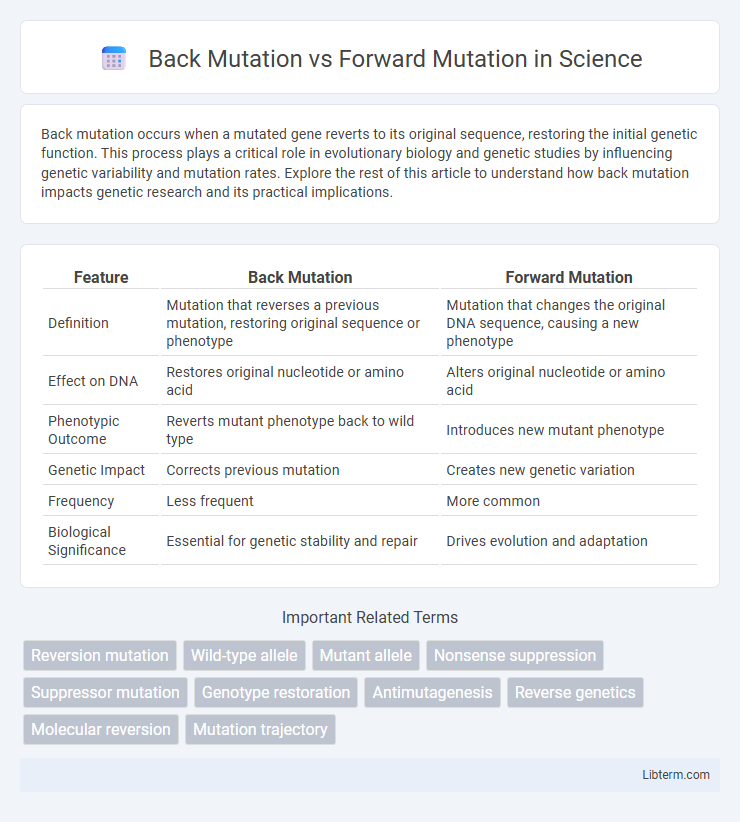Back mutation occurs when a mutated gene reverts to its original sequence, restoring the initial genetic function. This process plays a critical role in evolutionary biology and genetic studies by influencing genetic variability and mutation rates. Explore the rest of this article to understand how back mutation impacts genetic research and its practical implications.
Table of Comparison
| Feature | Back Mutation | Forward Mutation |
|---|---|---|
| Definition | Mutation that reverses a previous mutation, restoring original sequence or phenotype | Mutation that changes the original DNA sequence, causing a new phenotype |
| Effect on DNA | Restores original nucleotide or amino acid | Alters original nucleotide or amino acid |
| Phenotypic Outcome | Reverts mutant phenotype back to wild type | Introduces new mutant phenotype |
| Genetic Impact | Corrects previous mutation | Creates new genetic variation |
| Frequency | Less frequent | More common |
| Biological Significance | Essential for genetic stability and repair | Drives evolution and adaptation |
Introduction to Genetic Mutations
Back mutation restores the original nucleotide sequence by reversing a prior genetic change, effectively returning the organism to its initial genotype. Forward mutation introduces a new change in the DNA sequence, altering the genetic code and potentially affecting phenotype. Both types of mutations play crucial roles in genetic variability and evolutionary processes.
Definition of Forward Mutation
Forward mutation refers to the genetic alteration where a wild-type allele changes into a mutant allele, resulting in a loss or modification of the original gene function. This mutation type contrasts with back mutation, which reverses the mutant allele back to the wild-type sequence, restoring gene function. Forward mutations play a crucial role in genetic variation and are commonly studied in mutation rate experiments and evolutionary biology.
Definition of Back Mutation
Back mutation, also known as reverse mutation, is a genetic change that restores the original wild-type sequence or phenotype by reversing the effect of a previous mutation. It occurs when a nucleotide substitution, insertion, or deletion reverts to the original base or sequence, thereby reestablishing normal gene function. Forward mutation, in contrast, refers to the initial change from the wild-type allele to a mutant form that alters the gene's function or expression.
Molecular Mechanisms Involved
Back mutation involves the restoration of a mutated gene to its original wild-type sequence through precise nucleotide changes, often by reverting a base pair substitution or small insertion/deletion. Forward mutation refers to the initial alteration in the DNA sequence that changes the wild-type allele to a mutant form, commonly caused by errors during DNA replication, exposure to mutagens, or spontaneous base modifications. Both processes rely on molecular mechanisms such as DNA repair pathways, including mismatch repair and homologous recombination, to correct or propagate these changes at the genetic level.
Functional Consequences of Mutations
Back mutation restores the original DNA sequence, reversing the functional effect caused by the initial forward mutation, which alters gene expression or protein function. Forward mutation results in a new genetic variant that can lead to loss of function, gain of function, or altered protein activity, impacting cellular processes and phenotype. The functional consequences of these mutations are critical in genetic studies, disease mechanisms, and evolutionary biology.
Frequency and Occurrence in Populations
Back mutation restores a mutated allele to its original sequence, often occurring at lower frequencies due to the limited likelihood of precise reversal changes, while forward mutation introduces new genetic variations by altering the original allele, generally exhibiting higher occurrence rates in populations. The frequency of forward mutations is typically higher because many types of base substitutions or insertions can disrupt gene function, whereas back mutations require an exact nucleotide reversal. In populations, forward mutations drive genetic diversity and evolution, whereas back mutations tend to maintain genetic stability by reverting potentially deleterious changes.
Detection Methods for Forward and Back Mutations
Detection methods for forward mutations primarily include PCR-based techniques, such as allele-specific PCR and qPCR, which target the identification of novel mutations in DNA sequences. Back mutation detection often relies on reversion assays and DNA sequencing to confirm the restoration of the original genotype or phenotype. Both mutation types can be efficiently analyzed using next-generation sequencing (NGS) for comprehensive genetic profiling.
Biological Significance and Evolutionary Impact
Back mutation restores the original DNA sequence, reversing previous genetic changes and potentially recovering lost protein functions, which can stabilize essential biological processes. Forward mutation introduces new genetic variations by altering the original sequence, driving diversity and adaptation within populations. The balance between these mutations influences evolutionary dynamics by enabling both the correction of deleterious mutations and the generation of novel traits essential for species survival.
Examples in Human Genetics and Disease
Back mutation, or reverse mutation, restores the original DNA sequence, exemplified by cystic fibrosis patients where a secondary mutation reverts the CFTR gene to its functional form, alleviating symptoms. Forward mutation involves a change from the wild-type to a mutant allele, as seen in sickle cell anemia where a single nucleotide substitution in the HBB gene causes abnormal hemoglobin formation. Both mutation types critically influence the genetic landscape of human diseases by either reversing or causing pathogenic phenotypic changes.
Summary and Future Perspectives
Back mutation restores the original DNA sequence, reversing the effects of a previous mutation, while forward mutation introduces a new alteration that changes the original genetic code. Understanding the mechanisms and rates of these mutations is critical for genetic research, disease treatment, and evolutionary studies. Future perspectives involve leveraging advances in genome editing and molecular biology to precisely control mutation directionality for therapeutic interventions and improving genetic stability in populations.
Back Mutation Infographic

 libterm.com
libterm.com